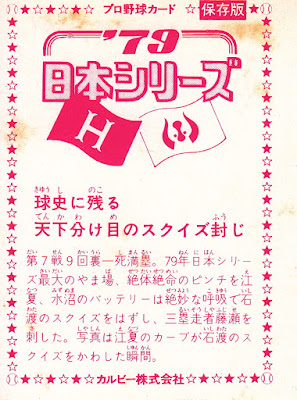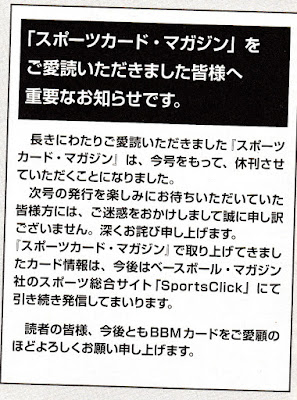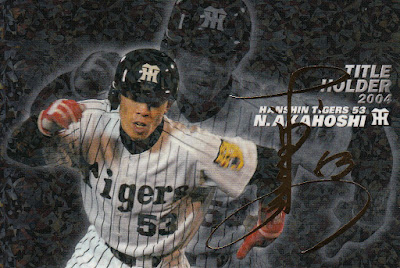One of the things I've been fascinated by over the years is when Japanese players have come to North America to play in minor leagues (such as
the Seibu Lions players who played for San Jose in the 1980's). I've always wanted to put together a comprehensive list but I didn't really know where to start until I recently came across
a list of Japanese minor leaguers on Japanese Wikipedia.
The San Francisco Giants of the 1960's and early 1970's appear to have been the go-to organization for Japanese players at the time. The most famous of these players of course was
Masanori Murakami. Murakami was one of several players sent by Nankai to play in the Giants minor league organization in 1964. He spent most of the season at Fresno in the Class A California League before being called up to the big league team in September. He played for the Giants Arizona instructional league team also that year and pitched for the big league Giants in 1965 before returning to Nankai in 1966. He remained with the Hawks until 1974, spent 1975 with Hanshin and spent 1976-82 with Nippon Ham. (And if you're interested in reading more about Murakami, check out Rob Fitts' 2015 book "
Mashi".)
 |
| 2009 Epoch All Japan Baseball Foundation 15th Anniversary #47 |
Three other Nankai players played in the US in 1964.
Hiroshi Takahashi and
Tatsuhiko Tanaka spent the season with the Magic Valley Cowboys of the Pioneer League and
Shozo Nishimura was a teammate of Murakami's with the Giants Arizona Instructional League team. Takahashi had the longest career of the three - he had an 18 year career with the Hawks (1965-71), the Toei/Nittaku Home Flyers/Nippon Ham Fighters (1972-76) and the Lotte Orions (1977-82). Tanaka (whose
Baseball Reference page for his NPB seasons doesn't include his minor league stats) played only a handful of games in 1965 and 1966 - he attempted a comeback as a pitcher under the name Tatsuhiko Yoshikawa but he never made it back to the ichi-gun team and he retired in 1969. Nishimura appeared in a few more games for Nankai over the same time period and retired after the 1970 season.
 |
| 2008 BBM Lotte 40th Anniversary #29 |
Hidehiko "Hide" Koga was a pitcher for Kinki University but when the Yomiuri Giants signed him in 1962, he switched to the outfield. He was released by Yomiuri after the 1964 season and was invited to come to North America by Cappy Harada who was working as the San Francisco Giants' Far Eastern scout. Koga ended up back on the mound for the Giants' Arizona instructional league team in the fall of 1965 and then spent 1966 with the Decatur Commodores of the Class A Midwest League. The Giants must have let him go after that and I'm not sure what he did in 1967 but 1968 saw him pitching for the Lodi Crushers, the Chicago Cubs' team in the California League. In 1969 he was a member of Toru Mori's Tokyo Dragons of the ill-fated
Global League. He spent a couple offseasons in the early 1970's playing for Maracaibo in the Venezuelan Winter League before finally hanging up his spikes in 1973. He eventually ended up in the Hawks organization and became manager of the Salinas Spurs of the California League when Daiei had an agreement to provide players for the team - he's the first and so far only Japanese native to manage in the US. He managed Salinas from 1990 to 1992. He also coached for the Hawks (1996-2000) and Marines (2004-08) as well as for the Sonoma County Crushers of the independent Western League in 2001. (Source -
Japanese Wikipedia)
 |
| 1998 BBM Hawks #FD5 |
The Giants 1968 Arizona instructional league team featured another Japanese player -
Tadayoshi Iwasaki. Iwasaki was a second round pick of the Toyko Orions in the fall 1966 draft. He had played in 20 games with the
ichi-gun Orions in 1967 and 1968 before they apparently sent him to the Giants instructional league team that fall. Iwasaki would go on to play with the Orions until 1980 then finished his career with one season with the Nippon Ham Fighters in 1981. (The 1968 instructional league team also featured a Korean player named
Won-Kuk Lee who also pitched in Fresno and Jacksonville in the Giants organization from 1968 to 1970. He then spent 1972 through 1982 pitching for various teams in the Mexican League.)
In 1969 the Giants Arizona instructional league team had six Japanese players - four from the Taiyo Whales (
Isao Itoh,
Hiroshi Kito,
Makoto Matsubara and
Shigeyuki Takahashi) and two from the Nishitetsu Lions (
Kimiyasu Murakami and
Masashi Takenouchi). Matsubara was by far the best player of this group - he's a
Meikyukai member with over 2000 hits and hit 330 home runs in his 19 seasons with the Whales (plus another one in the one season he spent with Yomiuri in 1981). He was an 11 time All Star. Isao Itoh also had a 20 year career - 18 with Taiyo (1961-78) and 2 with Nankai (1979-80). He was the starting catcher for the Whales for 11 years and made the All Star team five times. Hiroshi Kito was with the Whales from 1965 to 1975 except for one season with Lotte in 1973. Of those 11 years however he only made appearances with the
ichi-gun team in eight seasons. His best season was in 1970 (the season after he was with the Giants AIL team) - he went 13-12 with a 2.40 ERA and threw a no-hitter against Yakult on June 9th of that season. Shigeyuki Takahashi was with Taiyo from 1962 to 1980. His best season was 1965 when he went 21-17 with a 2.40 ERA. The 1969 Arizona instructional league was not his only playing experience in the US - he spent the 1972 season with the Phoenix Giants, the San Francisco Giants' AAA Pacific Coast League affiliate. He was a coach for the Hanshin Tigers after he retired as a player and returned again to the US to coach in the Detroit Tigers organization when Hanshin loaned a couple players to them. He coached at Niagara Falls (Short-season Class A New York-Penn League) in 1992 and Bristol (Rookie Level Appalachian League) in 1993-94. Kimiyasu Murakami was a fourth round pick of the Lions in the 1966 draft. He was with the Lions from 1967-71 and with Lotte from 1972-77. He was suspended for more than half of the 1970 season due to his involvement with the
Black Mist Scandal. Masashi Takenouchi was a third round pick of the Lions in the 1967 draft. He played for Lions from 1968 to 1978 before being traded along with Akinobu Mayumi to Hanshin in the deal that brought Koichi Tabuchi to the now Seibu Lions. He played with the Tigers until 1982.
 |
| 1976 Yamakatsu JY1 Makoto Matsubara |
 |
| 1974/75 Calbee #781 Isao Itoh |
 |
| 2012 BBM No-Hitters #50 |
 |
| 2015 BBM Whales Achievement #01 Shigeyuki Takahashi |
 |
| 2005 BBM Marines #M096 |
 |
| 1975/76 Calbee #529 Masashi Takenouchi |
Hiroshi Suzuki signed a contract with the San Francisco Giants after graduating from Daito Bunka University - I believe that he was the first Japanese player to sign directly with an MLB organization. He played for two teams in 1970 - the Decatur Commodores of the Class A Midwest League and the Great Fall Giants of the Rookie Level Pioneer League. He had a very poor season - hitting .111 with Decatur and .156 with Great Falls - and was released at the end of the season. He returned to Japan and taken by Lotte in the 15th (and final) round of the 1971 NPB draft. He retired after only one season with the Orions' farm team in 1972.
Toru Hamaura was Lotte's second round pick in the 1970 draft. After spending most of the 1971 season with the Orions' farm team he was apparently traded to the San Francisco Giants for Frank Johnson. Hamaura spent two seasons with the Fresno Giants, going a combined 20-15 with an ERA of 3.43. He returned to Japan in 1974, signing with the Lions who he played for until 1980. He returned to Lotte in 1981 but spent the entire season with the farm team before retiring at the end of the season.
The only player mentioned here who ended up on a US issued baseball card while they were playing in the US was Masanori Murakami, who had a card in the 1965 Topps set (
#282). Since the bulk of the minor league cards produced in North American didn't start until around 1975 this really isn't a big surprise. Koga and Takahashi both have cards when they were managing and coaching respectively in the early 1990's. There were two Salinas team sets issued each year Koga managed them and he appears in all six sets -
1990 Cal League,
1990-
91 ProCards,
1991-
92 Classic/Best and
1992 Fleer/ProCards. Takahashi appears in the 1992 Niagara Falls Rapids team sets from both
Classic/Best and
Fleer/ProCards and the
1993 Fleer/ProCards and the
1994 Classic/Best Bristol Tigers sets.
 |
| 1991 Classic/Best Salinas Spurs #24 |
I've not been able to locate any Japanese cards for Tatsuhiko Tanaka, Shozo Nishimura, Hideyuki Koga (as a player anyway), Tadayoshi Iwasaki, Hiroshi Suzuki or Toru Hamura.

















































